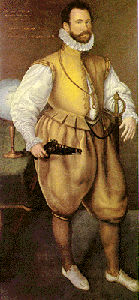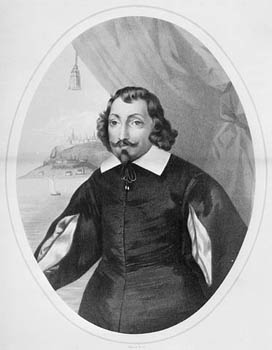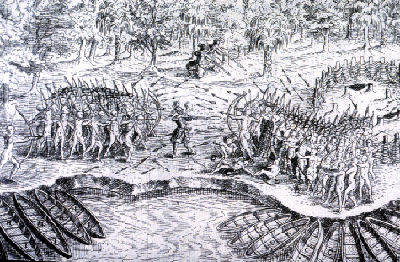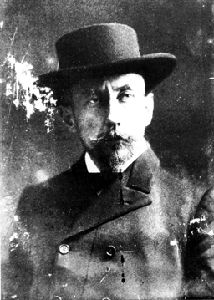Exploration
This timeline traces the history of exploration in Canada

-
January 01, 0985
Exploration
Bjarni Sights America
Bjarni Herjolfsson sighted mainland North America, probably Newfoundland, southern Labrador and Baffin Island. Bjarni was likely the first European to visit North America, and his discovery led to a brief Norse colonization of Newfoundland.
-
June 24, 1497
Exploration
John Cabot Claims Atlantic Coast
John Cabot landed on the Atlantic coast of North America, claiming it for England. Cabot's discovery led to England's interest in what is now Atlantic Canada, especially the fishery.
-
October 21, 1520
Exploration
Magellan Rounds S America
Portuguese explorer Ferdinand Magellan discovered and entered the strait in South America that now bears his name.
-
April 27, 1521
Exploration
Magellan Killed
Portuguese navigator Ferdinand Magellan was killed by islanders in the Philippines. Only four of his crew eventually returned to Portugal on September 6, 1522, becoming the first people to sail around the world.
-
April 02, 1534

Exploration
Cartier Reaches Labrador
French explorer Jacques Cartier arrived on the coast of Labrador. He further explored the Gulf of St Lawrence, discovering the Magdalen Islands and PEI.
-
July 24, 1534

Exploration
Cartier Lands at Gaspé
Jacques Cartier is one of the first Europeans to enter the Gulf of the St. Lawrence River. In 1535, while on his second of three voyages, Cartier hears the Iroquoian word for village, kanata, and documents the name in his journal. The name Canada subsequently appears on the 1547 Harleian world map, indicating land north of the St. Lawrence.
-
August 10, 1535
Exploration
Name St-Laurent First Used
Jacques Cartier gave the name St-Laurent to a bay north of Ile d'Anticosti.
-
September 06, 1535
Exploration
Cartier Discovers Île-aux-Coudres
French explorer Jacques Cartier discovered the Île-aux-Coudres during the second of his three voyages.
-
September 14, 1535

Exploration
Cartier Reaches Stadacona
Jacques Cartier reached the Native village Stadacona (site of Québec) on his second voyage up the St Lawrence River.
-
October 02, 1535
Exploration
Cartier Reached Hochelega
French explorer Jacques Cartier sailed down the St. Lawrence River and reached the Iroquois village of Hochelega. Cartier’s log describes a walled village that was home to roughly 1,500 people living in about 50 enormous longhouses. A cairn set near the main entrance to McGill University commemorates the location of the village, which remains uncertain.
-
September 01, 1557

Exploration
Death of Cartier
Jacques Cartier died at Limoilou, near St-Malo, France.
-
August 11, 1576

Exploration
Frobisher Sights Baffin Island
Martin Frobisher sighted the bay in Baffin Island that now bears his name.
-
March 15, 1603

Exploration
Champlain's First Trip
Samuel de Champlain boarded the Bonne-Renommée at Honfleur, France, destined for New France, as a private passenger on Gravé Du Pont's expedition.
-
May 26, 1603

Exploration
Champlain Reaches Tadoussac
Samuel de Champlain reached Tadoussac on the north shore of the St Lawrence River and set foot for the first time in New France.
-
June 11, 1603

Exploration
Champlain Learns of Hudson Bay
Samuel de Champlain travelled nearly 60 km up the Saguenay River, and learned from the Montagnais tribe that a large saltwater body existed to the north (the Hudson Bay).
-
July 04, 1603
Exploration
Champlain Reaches Montréal
Samuel de Champlain explored the Saguenay River and journeyed up the St Lawrence River, reaching the Lachine Rapids and the future site of Montréal on July 4.
-
July 15, 1603

Exploration
Champlain Arrives at Gaspé
Samuel de Champlain arrived at Gaspé, where he first heard about Acadia.
-
September 02, 1604

Exploration
Champlain Explores Bay of Fundy
Samuel de Champlain began exploring the Bay of Fundy to seek an ideal site for a permanent settlement, becoming the first European to create a geographical description of the area.
-
September 05, 1606
Exploration
Expedition to Massachusetts
Samuel de Champlain and Jean de Poutrincourt launched another expedition from Port-Royal to explore the coast of Massachusetts, hoping to establish friendly relationships with the Secoudon and Messamouet in the area. Their efforts were met with hostility and soon abandoned.
-
August 11, 1607
Exploration
Port-Royal Abandoned
The Port-Royal settlement was abandoned on orders from France. On Sept 3, after skirting the Straits of Canso and mapping the Atlantic coastline from Cape Breton to the south of Cap Blanc, Samuel de Champlain and the other voyagers headed home to St Malo. Only Poutrincourt would return, in 1610.
-
April 13, 1608

Exploration
Champlain Leaves on 3rd Voyage
As lieutenant to the Sieur de Monts, Samuel de Champlain set out on his third voyage to New France. He arrived at Tadoussac on 3 June.
-
June 28, 1609

Exploration
Champlain Explores Haudenosaunee Country
Samuel de Champlain explored Haudenosaunee country, entering the Rivière des Iroquois (Richelieu), paddling upriver and reaching a great lake that would later bear his name.
-
July 30, 1609

Exploration
Champlain Battles the Haudenosaunee
Champlain and his First Nations allies battled the Haudenosaunee on Lake Champlain, beginning 150 years of war between Iroquois and French. Champlain's musket kills three and astonishes the enemy.
-
October 13, 1609

Exploration
Champlain Returns to France
Samuel de Champlain arrived back in France, ready to report to the king on the success of New France and extol the virtues of the Québec habitation as a warehouse for the fur trade.
-
August 03, 1610

Exploration
Hudson Enters Hudson Bay
Henry Hudson entered Hudson Bay. He wintered on the coast of James Bay.
-
August 08, 1610

Exploration
Champlain Sets Sail for France
After a disastrous year for the fur trade, Samuel de Champlain set sail for France, leaving behind 16 men under the command of Jean de Godet Du Parc.
-
May 28, 1611

Exploration
Champlain Leaves for Lachine
Samuel de Champlain left Québec and arrived at Lachine and named the island in the middle of the St Lawrence River St. Hélène for his wife.
-
June 13, 1611

Exploration
Champlain Shoots Rapids
Samuel de Champlain impressed his native allies by shooting the dangerous Lachine Rapids in a canoe.
-
June 23, 1611

Exploration
Hudson's Crew Mutinies
Henry Hudson's crew mutinied and set Hudson, his son John and 7 others adrift in a small boat. They were never heard from again.
-
May 29, 1613

Exploration
Champlain Reaches Ottawa River
Champlain reached the mouth of the Ottawa River. On June 4 he noted the mouths of the Gatineau and Rideau rivers at the present site of Ottawa.
-
September 26, 1613

Exploration
Champlain Promotes New France
Champlain left for France, where he remained until April 24, 1615 to promote the cause of New France.
-
May 25, 1615
Exploration
Récollets Arrive
Four Récollets from France arrived at Tadoussac with Champlain, only to quickly go their separate ways. The best-known Récollet, Gabriel Sagard, later published Le Grand Voyage du pays des Hurons, an indispensable source of knowledge of Huron customs and culture.
-
July 01, 1615

Exploration
Champlain Visits Huronia
French explorer Samuel de Champlain reached Huronia, at the southern end of Georgian Bay.
-
July 09, 1615

Exploration
Champlain Treks Up Ottawa River
Samuel de Champlain began his journey up the Ottawa River, passing through the Lac des Népissingues (Lake Nipissing), the Rivière des Français (French River) and the great Lac Attigouautau (Lake Huron). He arrived among the Hurons on 1 August.
-
August 01, 1615

Exploration
Champlain Arrives at Huronia
Samuel de Champlain completed his journey up the Ottawa River, arriving among the Hurons.
-
January 15, 1616

Exploration
Champlain Leaves Huronia
Samuel de Champlain left Huronia to visit the Tobacco Nation (south of Nottawasaga Bay), then the Cheveux-Relevés (Ottawas, south of Georgian Bay), extending an invitation to the natives to come to Québec.
-
September 10, 1616

Exploration
Champlain Returns with Map
Samuel de Champlain arrived in France, where he would publish an engraved map of New France.
-
July 07, 1620
Exploration
Récollet Arrives in Québec
Récollet lay brother Gabriel Sagard arrived at Québec. He was the author of The Long Journey to the Country of the Hurons.
-
March 23, 1633

Exploration
Champlain's Final Voyage
Samuel de Champlain set sail on his final voyage to Québec at age 63.
-
March 23, 1670
Exploration
Explorers Reach Lake Erie
Fathers Dollier de Casson and Galinée claimed Lake Erie for France.
-
June 15, 1673
Exploration
French Reach Mississippi
Explorers Jolliet and Marquette arrived at the upper reaches of the Mississippi River.
-
April 09, 1682

Exploration
La Salle Reaches Mouth of the Mississippi
The La Salle expedition passed the mouth of the Mississippi River.On April 9 he claimed the entire region for Louis XIV.
-
April 09, 1682

Exploration
La Salle Claims Louisiana
La Salle, de Tonty and Jacques Bourdon d'Autray arrived at the Mississippi Delta. La Salle claimed the territory he had explored for France and named it Louisiana.
-
March 19, 1687

Exploration
La Salle Assassinated
La Salle was assassinated by his own men in present-day Texas.
-
August 26, 1731

Exploration
La Vérendrye at Grand Portage
La Vérendrye and his three sons reached Grand Portage. In the autumn they built Fort Saint-Pierre, the first of 8 posts.
-
October 03, 1738

Exploration
Fort La Reine Founded
La Vérendrye arrived at the site of Portage-la-Prairie on the Assiniboine River, where he built Fort La Reine.
-
January 01, 1743

Exploration
La Vérendryes Sight Rockies
The La Vérendryes sighted the Rocky Mountains, most likely the Big Horn Range.
-
March 30, 1743

Exploration
La Vérendrye's Plaque
La Vérendrye left a metal plate inscribed "Posé par le Chevalier de la Lavérendre le 30 Mars 1743" in the northwest. It was recovered in 1913 near Pierre, South Dakota.
-
July 24, 1754

Exploration
Henday in the West
Anthony Henday reached Fort Paskoyac; he later reached a Blackfoot camp southwest of present-day Red Deer, being likely the first European to set foot in territory that became Alberta.
-
July 17, 1771

Exploration
Hearne Reaches the Arctic
Samuel Hearne, exploring inland from Churchill with his Native guide Montonabbe, reached the Arctic Ocean via the Coppermine River; he returned via Great Slave Lake.
-
July 15, 1774

Exploration
Juan Pérez Hernández
Spanish explorer Juan Josef Pérez Hernández sighted the Queen Charlotte Islands.
-
July 12, 1776
Exploration
Cook Sails from Plymouth
In search of a Pacific-coast exit from the Northwest Passage, Captain James Cook set sail on his third and final voyage. Though he would discover the Sandwich Islands (now the Hawaiian Islands) on this voyage, Cook's expedition was blocked entry to the Northwest Passage by a frozen Bering Strait.
-
March 29, 1778

Exploration
Cook Sights Vancouver Island
Captain James Cook sighted land at Vancouver Island. He landed at Nootka, sighted Mount Elias (10 May) and continued north to Alaska and the Bering Strait.
-
May 05, 1789

Exploration
Martinez Reaches Nootka
A Spanish expedition under Esteban José Martinez reached Nootka Sound and plundered a number of British ships, touching off the Nootka Sound Controversy.
-
July 10, 1789

Exploration
Mackenzie Reaches Arctic
Alexander Mackenzie travelled down the Mackenzie River and reached the Arctic Delta.
-
June 22, 1792
Exploration
Spanish Sight Vancouver
Spanish explorers Alcalà-Galiano and Valdés sighted George Vancouver's ships Discovery and Chatham near present-day Vancouver. Each side was mortified to discover its major competitor.
-
July 21, 1793

Exploration
Mackenzie Reaches the Pacific
Alexander Mackenzie party reached the Pacific via the Bella Coola River, the first explorer to complete the journey overland. Though a physical triumph, Mackenzie's achievement failed to provide the fur traders with a viable route.
-
May 12, 1798
Exploration
Death of George Vancouver
British naval officer and explorer George Vancouver, known for his exploration of the BC Pacific coast, died at London, England.
-
October 28, 1798
Exploration
Death of Estéban José Martinez
Spanish naval officer Estéban José Martinez, whose seizure of several trading vessels in Nootka Sound during the summer of 1789 touched off a confrontation with England, died at Loreto, Mexico.
-
July 02, 1808

Exploration
Fraser Reaches Pacific
Simon Fraser reached the Pacific, after descending the river that now bears his name.
-
July 15, 1811

Exploration
Thompson Ascends Columbia River
David Thompson, descending the Columbia River, reached the Pacific Ocean at Cape Disappointment, a few weeks after American traders had staked their claim.
-
June 01, 1831

Exploration
North Magnetic Pole Found
Sir James Clark Ross located the North Magnetic Pole. He set up the British flag, took possession of the North Magnetic Pole and adjoining territory in the name of King William IV, and erected a cairn.
-
January 10, 1850

Exploration
Search for Franklin Begins
Robert McClure and Richard Collinson began the extensive search for Franklin, likely the greatest search mission in the history of exploration. In the process, more was revealed of the geography of the North than at any other time.
-
April 15, 1853

Exploration
Rae Searches for Franklin
John Rae set out from Fort Confidence on a search for Sir John Franklin. He covered 1126 km of previously unknown coastline.
-
October 22, 1854

Exploration
Rae Learns Fate of Franklin
John Rae learned of the fate of Franklin and his crew from Inuit around Pelly Bay. Franklin's ship had become frozen into the northern ice in 1846, setting off one of the most extensive rescue operations in the history of exploration. Based on Inuit reports and evidence of personal effects, John Rae claimed the £10,000 reward for settling Franklin's fate.
-
March 13, 1900

Exploration
Tyrrell's Survey
J.W. Tyrrell began a 2782 km journey to survey the area from Great Slave Lake to Chesterfield Inlet.
-
April 21, 1902
Exploration
Peary Turns Back
Robert Peary turned back at 84°17' north latitude, in his attempt to reach the North Pole.
-
August 26, 1905

Exploration
Amundsen Completes Passage
Roald Amundsen, travelling west of King William Island, sighted an American whaling ship that had come from San Francisco. At this point, he knew that he had achieved the Northwest Passage, a quest that had obsessed explorers for nearly 400 years.
-
November 05, 1905

Exploration
Amundsen Tells World of Achievement of Passage
Roald Amundsen and an American companion reached Eagle City, Alaska, after a voyage by dog sled over 800 km of ice from his ice-bound ship. There he was able to use the telegraph to announce to the world that he had completed the Northwest Passage.
-
April 06, 1909
Exploration
Peary Reaches North Pole
American explorer Robert Peary claimed to be the first person to reach the North Pole.
-
December 14, 1911
Exploration
Amundsen Reaches South Pole
Roald Amundsen and 4 companions were the first humans to reach the South Pole.
-
January 18, 1912
Exploration
Scott Reaches South Pole
British explorer Robert Scott and four others reached the South Pole, only to find Norwegian Roald Amundsen had beaten him by a month. None of Scott's expedition survived.
-
May 07, 1928
Exploration
St. Roch Launched
The RCMP schooner St. Roch was launched at the Burrard Shipbuilding & Drydock Company, North Vancouver, BC. It would become the first ship to sail the Northwest Passage from west to east and to circumnavigate North America.
-
June 18, 1928

Exploration
Amundsen Lost
Roald Amundsen, Norwegian polar explorer, was lost on a rescue mission in the Arctic.
-
June 23, 1940

Exploration
West to East Northwest Passage
An RCMP patrol commanded by Henry Asbjorn Larsen sailed from Vancouver in the St. Roch. They reached Halifax via the Arctic, in the first successful west to east navigation of the Northwest Passage.
-
October 11, 1942

Exploration
St. Roch Arrives in Halifax
The St. Roch arrived in Halifax after navigating the Northwest Passage from west to east.
-
July 22, 1944

Exploration
St. Roch Leaves Halifax
The RCMP ship St. Roch left Halifax to return to Vancouver by the Northwest Passage; the trip was completed 86 days later.
-
October 16, 1944
Exploration
St. Roch Arrives in Vancouver
The RCMP ship St. Roch arrived in Vancouver from Halifax via the Northwest Passage, the first ship to have sailed the passage in both directions.
-
May 29, 1950

Exploration
St. Roch Completes Voyage
The RCMP ship St. Roch reached Halifax after passing through the Panama Canal from Vancouver. It was the first ship to circumnavigate North America.
-
December 14, 2000
Exploration
St. Roch II Arrives in Victoria
The St. Roch II arrived in Victoria, BC, after repeating the historic trip of its predecessor, the St. Roch, which in 1944 became the first ship to traverse the Northwest Passage.
-
September 30, 2009
Exploration
Laliberté Travels to Space
Cirque du Soliel creator Guy Laliberté became the first Canadian civilian to enter space, a mission he hoped would increase awareness of the need for global water conservation. Donning a red clown nose, Laliberté blasted off to a chorus of Elton John's "Rocket Man" from cheering fans below. The ride aboard Russian Soyuz craft cost the billionaire entertainer US $35 million.
-
September 09, 2014

Exploration
Franklin Expedition Ship Discovered
The HMS Erebus, one of Sir John Franklin's expedition ships, was found submerged off the coast of King William Island. The ship was part of Sir John Franklin's 1845 expedition to find the Northwest Passage from the Atlantic Ocean to Asia.
-
September 12, 2016

Exploration
Discovery of HMS Terror
A team from the Arctic Research Foundation (founded by Jim Balsillie) announced that they had found the second lost ship of the Franklin expedition, HMS Terror, in Nunavut’s Terror Bay, north of where the Erebus was found in 2014. The discovery was confirmed by Parks Canada on 26 September 2016.

